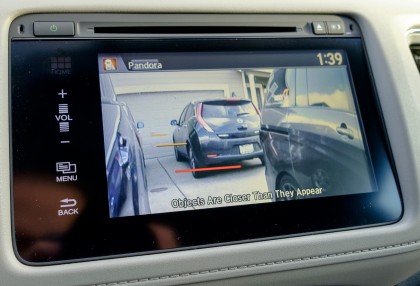Why you can trust TechRadar
Audio quality in the HR-V is not something I enjoyed listening to. The EX and EX-L trims get a six-speaker system with 180 watts of power, a bump from the base LX trim four-speaker and 160-watt setup, but it's far from adequate to my ears.
The bass is muddy and overpowers the tweeters. You can turn up the treble and the bass down, but I was unable to find a balance that left me with any form of tolerable bass.
However, if you're into installing your own sound system, the HR-V is ready for an upgrade. It employs standard 6.75-inch speakers with separate tweeters in the front and single speakers in the back, which are available from all the aftermarket brands.
Driver assists
Honda offers very few driver assist technologies in the US-market HR-V. While Europe and Australia get lane departure and forward collision warning systems, the US only gets backup and LaneWatch cameras. I asked Honda why the US does not get the driver assists and was told it was because of market preferences and price point, unfortunately.

Nevertheless, Honda does go above and beyond with the backup camera by offering selectable viewing angles. I never found the need to change the camera angles when backing up the car, but at least the option is available for those that rely heavily on it. The HR-V backup camera has active guidelines that turn with the steering wheel to provide an estimate of where the car will end up at its current trajectory, too.
Radar-based blind spot monitor (BSM) systems are typically what automakers offer on cars. The typical BSM has a visual indicator that flashes in or on the side mirrors. Honda takes a different approach to letting drivers see what's in their blind spot with LaneWatch technology. The HR-V EX and EX-L trims include the technology, which installs a camera in the passenger side mirror to provide the driver with a view of what's in the adjacent lane.

When you use the right turn signal, LaneWatch activates and provides a view of the right side of the car on the infotainment screen. Guidelines are displayed to show where a car in the adjacent lane is in relation to your car.
Sign up for breaking news, reviews, opinion, top tech deals, and more.
The system seems simple enough, but I find it hard to get used to. My default process for right lane changes is to scan my side and rear view mirrors, put on the turn signal, perform a quick head check and move over.
The process of checking the side mirror and performing head checks relies on looking at the right side of the car, not the infotainment screen. There's also a minor delay from when you flip the turn signal stalk to when the image displays, so it's not ideal for quick maneuvers. I find myself not using LaneWatch much at all with the HR-V.

If you're so inclined, the LaneWatch camera is available any time with a press of a button on the turn signal stalk. The other problem with LaneWatch is it only covers the right side of the car, so you still have to perform head checks as usual when changing into the left lane.
As to why Honda opted to incorporate a camera instead of a radar-based BSM system, the company sees the radar-based system as a premium feature. Radar-based BSM is available on top trim levels of the Honda Pilot and premium Acura vehicles.
Current page: Audio and driver assists
Prev Page Design, interior and infotainment Next Page Performance and living with it